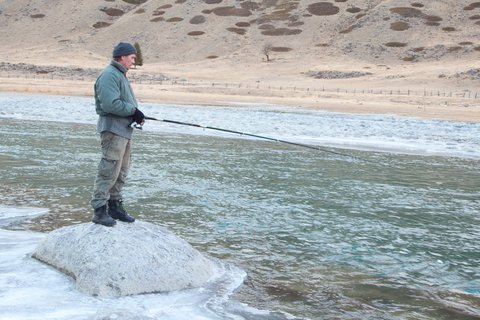The winter fly fishing season for stream trout can be one of the most unique experiences in which fly anglers can participate. Matching insect hatches in the snow seems contrary to everything you know about winter, but it is certainly a challenge and a great way to pass the cold winter months.
In the northern climates, most of the trout streams available for winter angling are spring fed. During the winter, spring water enters a stream in the mid 50-degree range, which helps the streams to remain ice free, even when the air temperature is well below freezing.
This relatively warm water also helps to keep a variety of insect species active during the winter months. While anglers will not see impressive hatches such as the mayfly or caddis that are typical in the spring and summer, you will see insect activity.
Stream trout are cold-water species, but the cold of winter still slows their metabolism. The fish are typically sluggish and unwilling to move far to take your offering. This means, to be successful during the winter season, you need to slow down your approach. Work your flies slowly through each stream section, making multiple casts to cover every inch of water. It is not unusual to have to put a fly right on a trout’s nose in order to get it to strike.
Yet even in the heart of winter, anglers will notice increased trout activity on warmer days (especially when temps rise above the freezing mark) and when insect activity is the highest.
The most common insect hatches of winter are midges. These tiny insects hatch on an almost daily basis on some streams. Often you can see them leaving the water and landing on the snow. Since midges are so prevalent during the winter, one of the most popular winter flies is the black gnat. This is an effective midge imitation that will consistently take trout all winter.
Even though midges tend to dominate in the winter, it is important not to forget the other aquatic life in the stream. A variety of nymphs are active in the water, meaning you can also take fish with all-around nymph imitations like the pheasant tail or hare’s ear.
Minnows are another important food source for trout in winter. Any fly that imitates a minnow can work well during the winter season.
It is important to note that stream levels are typically lower during the winter months and water tends to be clearer than normal, so anglers should use extra care when approaching trout. Stay low, move slowly, keep the noise to a minimum and wear clothing that blends in to your surroundings.
Finally, anglers can help ensure the survival of trout by limiting their exposure to the cold air, especially if temperatures are well below freezing. If possible, remove the hook while the fish is still in the water. Extremely cold temperatures can damage the trout’s sensitive gills and lead to mortality.
Follow these tips and you can enjoy some exceptional fly fishing opportunities this winter.








